Prominent axonopathy and disruption of axonal transport in transgenic mice expressing human apolipoprotein E4 in neurons of brain and spinal cord
- PMID: 11073810
- PMCID: PMC1885744
- DOI: 10.1016/S0002-9440(10)64788-8
Prominent axonopathy and disruption of axonal transport in transgenic mice expressing human apolipoprotein E4 in neurons of brain and spinal cord
Abstract
The epsilon 4 allele of the human apolipoprotein E gene (ApoE4) constitutes an important genetic risk factor for Alzheimer's disease. Recent experimental evidence suggests that human ApoE is expressed in neurons, in addition to being synthesized in glial cells. Moreover, brain regions in which neurons express ApoE seem to be most vulnerable to neurofibrillary pathology. The hypothesis that the expression pattern of human ApoE might be important for the pathogenesis of Alzheimer's disease was tested by generating transgenic mice that express human ApoE4 in neurons or in astrocytes of the central nervous system. Transgenic mice expressing human ApoE4 in neurons developed axonal degeneration and gliosis in brain and in spinal cord, resulting in reduced sensorimotor capacities. In these mice, axonal dilatations with accumulation of synaptophysin, neurofilaments, mitochondria, and vesicles were documented, suggesting impairment of axonal transport. In contrast, transgenic mice expressing human ApoE4 in astrocytes remained normal throughout life. These results suggest that expression of human ApoE in neurons of the central nervous system could contribute to impaired axonal transport and axonal degeneration. The possible contribution of hyperphosphorylation of protein Tau to the resulting phenotype is discussed.
Figures

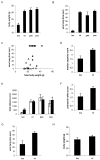
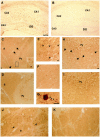

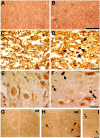
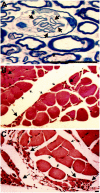
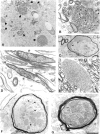
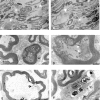
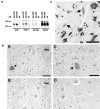
Similar articles
-
Neuron-specific apolipoprotein e4 proteolysis is associated with increased tau phosphorylation in brains of transgenic mice.J Neurosci. 2004 Mar 10;24(10):2527-34. doi: 10.1523/JNEUROSCI.4315-03.2004. J Neurosci. 2004. PMID: 15014128 Free PMC article.
-
Expression of human apolipoprotein E4 in neurons causes hyperphosphorylation of protein tau in the brains of transgenic mice.Am J Pathol. 2000 Mar;156(3):951-64. doi: 10.1016/S0002-9440(10)64963-2. Am J Pathol. 2000. PMID: 10702411 Free PMC article.
-
Human apolipoprotein E2, E3, and E4 isoform-specific transgenic mice: human-like pattern of glial and neuronal immunoreactivity in central nervous system not observed in wild-type mice.Neurobiol Dis. 1996;3(3):229-45. doi: 10.1006/nbdi.1996.0023. Neurobiol Dis. 1996. PMID: 8980023
-
Apolipoprotein E isoforms in Alzheimer's disease pathology and etiology.Microsc Res Tech. 2000 Aug 15;50(4):278-81. doi: 10.1002/1097-0029(20000815)50:4<278::AID-JEMT5>3.0.CO;2-T. Microsc Res Tech. 2000. PMID: 10936880 Review.
-
Astrocyte lipoproteins, effects of apoE on neuronal function, and role of apoE in amyloid-beta deposition in vivo.Microsc Res Tech. 2000 Aug 15;50(4):297-304. doi: 10.1002/1097-0029(20000815)50:4<297::AID-JEMT9>3.0.CO;2-C. Microsc Res Tech. 2000. PMID: 10936884 Review.
Cited by
-
Neuron-specific apolipoprotein e4 proteolysis is associated with increased tau phosphorylation in brains of transgenic mice.J Neurosci. 2004 Mar 10;24(10):2527-34. doi: 10.1523/JNEUROSCI.4315-03.2004. J Neurosci. 2004. PMID: 15014128 Free PMC article.
-
Apolipoprotein E4: a causative factor and therapeutic target in neuropathology, including Alzheimer's disease.Proc Natl Acad Sci U S A. 2006 Apr 11;103(15):5644-51. doi: 10.1073/pnas.0600549103. Epub 2006 Mar 27. Proc Natl Acad Sci U S A. 2006. PMID: 16567625 Free PMC article. Review.
-
Apolipoprotein E-related neurotoxicity as a therapeutic target for Alzheimer's disease.J Mol Neurosci. 2003;20(3):327-37. doi: 10.1385/JMN:20:3:327. J Mol Neurosci. 2003. PMID: 14501016
-
APOEε4 potentiates the relationship between amyloid-β and tau pathologies.Mol Psychiatry. 2021 Oct;26(10):5977-5988. doi: 10.1038/s41380-020-0688-6. Epub 2020 Mar 11. Mol Psychiatry. 2021. PMID: 32161362 Free PMC article.
-
Neuronal ApoE4 in Alzheimer's disease and potential therapeutic targets.Front Aging Neurosci. 2023 Jun 2;15:1199434. doi: 10.3389/fnagi.2023.1199434. eCollection 2023. Front Aging Neurosci. 2023. PMID: 37333457 Free PMC article. Review.
References
-
- Corder EH, Saunders AM, Strittmatter WJ, Schmechel DE, Gaskell PC, Small GW, Roses AD, Haines JL, Pericak-Vance MA: Gene dose of apolipoprotein E type 4 allele and the risk of Alzheimer’s disease in late onset families [see comments]. Science 1993, 261:921-923 - PubMed
-
- Strittmatter WJ, Saunders AM, Goedert M, Weisgraber KH, Dong LM, Jakes R, Huang DY, Pericak-Vance M, Schmechel D, Roses AD: Isoform-specific interactions of apolipoprotein E with microtubule-associated protein tau: implications for Alzheimer disease. Proc Natl Acad Sci USA 1994, 91:11183-11186 - PMC - PubMed
-
- Olichney JM, Hansen LA, Galasko D, Saitoh T, Hofstetter CR, Katzman R, Thal LJ: The apolipoprotein E epsilon 4 allele is associated with increased neuritic plaques and cerebral amyloid angiopathy in Alzheimer’s disease and Lewy body variant. Neurology 1996, 47:190-196 - PubMed
-
- Nagy Z, Esiri MM, Jobst KA, Johnston C, Litchfield S, Sim E, Smith AD: Influence of the apolipoprotein E genotype on amyloid deposition and neurofibrillary tangle formation in Alzheimer’s disease. Neuroscience 1995, 69:757-761 - PubMed
-
- Gearing M, Mori H, Mirra SS: A beta-peptide length and apolipoprotein E genotype in Alzheimer’s disease. Ann Neurol 1996, 39:395-399 - PubMed
Publication types
MeSH terms
Substances
LinkOut - more resources
Full Text Sources
Molecular Biology Databases
Miscellaneous

